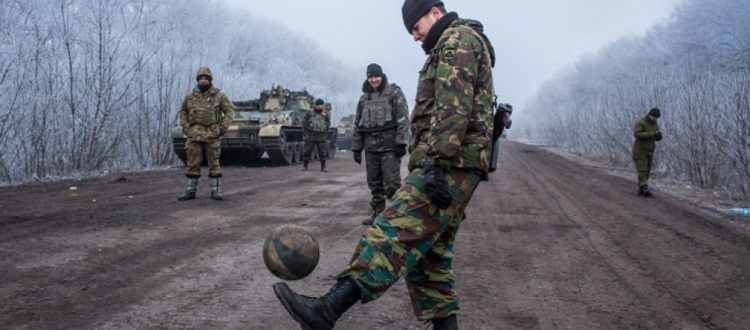Progress toward Ukraine, Donbas, Russia conflict resolution – serious negotiations still needed
Today, there is a need for dialogue, trust-building, and reconciliation within the country. The same issues as to what “self rule” means in practice is still the crucial issue. Ultimately, all conflicts can end only when there is an agreement about the shape of government and the rules of law under which people agree to live. While the discussions and compromises must be done among the Ukrainians themselves, persons in the other three States of the Normandy Format, Germany, France and Russia, familiar with con-federal structures, may provide some guidelines.
| Suggested Reading | Conflict Background | GCCT |
By Rene Wadlow
Although some media attention on the conversation between U.S. President Donald Trump and Ukrainian President Volodymyr Zelensky may overshadow all else that is happening in Ukraine, more important is the step on the path of progress taken on what has been termed “the Steinmeier Formula.” In the context of earlier negotiations held in Minsk, then Foreign Minister and now President of Germany, Frank-Walter Steinmeier proposed a compromise of returning control of the Ukraine frontier to the Ukrainian government, a withdrawal of troops and armaments, elections under the supervision of the Organization for Security and Cooperation in Europe (OSCE), and a status of “self rule” in the republics of Donbas and Luhansk. At the time, the Steinmeier Formula was to have been discussed and agreed to within the “Normandy Format”–a framework of negotiations among Russia, Ukraine, Germany and France. Unfortunately, the Normandy Format did not operate. Armed conflict and economic breakdown continues in the Donbas-Luhansk area. Some 13,000 persons have been killed and more wounded.
Now, with a new President of Ukraine and a need to reduce Russian-Western European tensions, President Zelinsky has agreed in a general way to the Steinmeier Formula. Serious negotiations are still needed. It is hoped that the “Normandy Format” can be put into operation with a meeting in Paris within a month’s time. President Macron and President Putin spoke briefly together in Paris on 30 September at the funeral for the former French President, Jacques Chirac.
Hard line nationalists and Right Wing political figures in Ukraine have attacked the agreement. Former Prime Minister Yulia Tymeshenko said the agreement was a “direct threat to the national security, territorial integrity and sovereignty of our country.” The Far Right National Corps leader Andrey Baletsky had even sharper terms. However, the nationalist Right has never had realistic propositions for a governmental structure that would recognize the specific economic and cultural nature of eastern Ukraine without creating totally independent countries or integrating Donbas and Luhansk into the Russian Federation as Crimea has been integrated. Thus, the crucial question today is what is the nature of the proposed “self rule” which is to follow the elections.
The Association of World Citizens, which is concerned with the development of appropriate structures of government as an important element in the resolution of armed conflicts, had proposed the creation of a federal or con-federal Ukraine. In a 14 April 2014 message to the Secretary General of the OSCE, the Association of World Citizens stressed that government structures should be as close as possible to the people so that their views can have a direct impact on government decisions. Federalist and con-federalist forms of government can facilitate the balance between the need for larger governmental units for policy making and units close to the local communities so that those impacted are able to influence policy.
The Association stressed that federalism is not a first step to the disintegration of the Ukraine. But it is not a “magic solution” either. Government structures are closely related to the aims which people wish to achieve. The aims of the Ukrainians are multiple. Dialogue and open discussion is needed so that these aims are seen more clearly, and then structures created to facilitate these aims.
In a follow up 3 May 2014 message, the Association stressed that there should be a link made between the proposed referendum in eastern Ukraine and the structure of the Ukrainian State. The 11 May 2014 referendum was organized in only part of eastern Ukraine, in what was then newly proclaimed as the Donetsk People’s Republic and the Luhansk People’s Republic. The question posed concerned “yes” or “no” on the Russian word samastoyatelnost” which can be translated as “self rule”. Since there had been no real public discussion, the term could mean – and did mean – different things to different people. People were discouraged from voting “no” and few did.
Today, there is a need for dialogue, trust-building, and reconciliation within the country. The same issues as to what “self rule” means in practice is still the crucial issue. Ultimately, all conflicts can end only when there is an agreement about the shape of government and the rules of law under which people agree to live. While the discussions and compromises must be done among the Ukrainians themselves, persons in the other three States of the Normandy Format, Germany, France and Russia, familiar with con-federal structures, may provide some guidelines.
Rene Wadlow is the President of the Association of World Citizens, an international peace organization with consultative status with ECOSOC, the United Nations organ facilitating international cooperation on and problem-solving in economic and social issues.
The views expressed in this article do not necessarily reflect the views of TransConflict.
Interested in writing for TransConflict? Contact us now by clicking here!



















